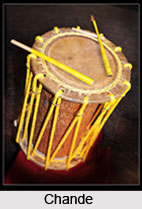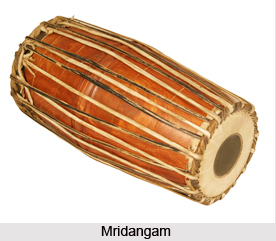 Carnatic Musical Instruments accompany the traditional Carnatic music, which is usually prevalent in the southern part of India. It is popular in the states of Karnataka, Andhra Pradesh, Tamil Nadu and Kerala. Carnatic music is one of the two sub genres of Indian classical music.
Carnatic Musical Instruments accompany the traditional Carnatic music, which is usually prevalent in the southern part of India. It is popular in the states of Karnataka, Andhra Pradesh, Tamil Nadu and Kerala. Carnatic music is one of the two sub genres of Indian classical music.
Chande
Chande is a percussion instrument used along with the traditional Carnatic music, especially in the state of Karnataka. It is a drum that provides rhythms in dance dramas like Yakshagana. It is played with the help of two sticks by placing it vertically on the floor. Chande rhythms are based on folk music and pre classical forms, and bear a close resemblance to Karnataka Sangeta. Different varieties of this instrument are found namely Badagu Thittu Chande and Thenku Thittu Chande.
Chenda
Chenda is another percussion instrument comprising of cylindrical wooden drum. It is played by hanging it vertically to the neck and beating the upper parchment. The instrument produces loud and rigid sound. Chenda is popular in temple festivals of Hindus and accompanies religious art forms and rituals Kerala. It also accompanies various dance forms like Koodiyattam, Theyyam, Kannyar Kali and Kathakali.
Electronic Tanpura
An Electronic Tanpura mimics the sound of Tanpura, a traditional string instrument of India. It is an essential commodity of Carnatic music and is a great substitute of real Tanpura. Electronic Tanpura is easier to use and is less expensive. G Raj Narayan was the inventor of this electronic instrument who demonstrated it for the first time at the annual conference of the Music Academy Chennai in December 1979. Electronic Tanpura serve greatly in the concerts as well as private practices.
 Ghatam
Ghatam
Another popular percussion instrument used in Carnatic music is Ghatam. Ghatam is basically a clay pot having a narrow mouth. The walls of this pot must have even thickness for producing even tones. It is one of the oldest instruments of south India. Manamadurai, near Madurai, is the place where most of the Ghatams are manufactured. The technique of playing this instrument involves placing the pot over the lap with its mouth facing towards the belly. Rhythms having a fast tempo are played greatly with Ghatam.
Gottuvadhyam
Gottuvadhyam is played mostly in south India and was previously known as Chitravina. Through years, it has undergone numerous changes and modifications. It is used extensively in north-south Indian jugalbandis and also in music concerts. Gottuvadhyam comprises of six main strings and twelve sympathetic strings.
Kanjira
Kanjira is a drum instrument used widely with Carnatic music. It is composed of circular frame of jack fruit tree wood. A drumhead made of monitor lizard skin covers one side of Kanjira. It is comparatively a complex instrument which requires playing with fingers and palm of right hand while supporting the drum with left hand. One of the most renowned Kanjira players in India is G Harishankar.
Maddale
Famous percussion instruments of Karnataka also enlist Maddale. It is the main rhythmic instrument used in Yakshagana along with Chande. Traditional Maddale is however high pitched and is shorter. Three variants of this instrument are found. Maddale comprises of a hollowed jack fruit wood and the mouths of it are covered with goat skin leather. These are laced with leather straps around the drum circumference. Often wooden pegs are used to tighten the leather straps.
 Mridangam
Mridangam
A number of percussion instruments are used in Carnatic music among which Mridangam is an important one. Hindu mythology, sculptures and paintings often associates this instrument with deities like Lord Ganesha and Lord Shiva. It is believed that, during tandava dance of Lord Shiva, Mridangam was played by Nandi which created divine rhythm across the universe. The wood used to make Mridangam had been changed numerous times for enhancing its durability and melody. Nowadays jackfruit tree wood is the most common choice. Various finger strokes create a variety of rhythmic sounds in Mrindangam.
Nadaswaram .
Nadaswaram is another famous musical instrument of Tamil Nadu. It is also the world`s loudest non brass instrument. In south India, this instrument is considered very auspicious and is thus played in the Hindu temples and weddings. Nadaswaram is usually played in pairs. Thiruvengadu Subramania Pillai, Thiruvidaimaruthur P. S. Veerusami Pillai, Subramania Pillai and Rajaratnam Pillai are the renowned players of this instrument who have gained country wide acclamation.
Ottu
Ottu is a wind instrument used in Carnatic music. It is double reed, large and conical instrument having two and a half feet of length. Ottu is provided with several tuning holes which are used for modifying the notes by blocking them with wax.
Saraswati Veena
 A popular string instrument of south India is Saraswati Veena. The instrument is named after Goddess Saraswati who, in Hindu mythology, has been depicted to hold or play this instrument. This instrument has a peculiar make having curved string terminations at the end. Several variations of Veena have developed over time among which Saraswati Veena is an important one used extensively in Carnatic music.
A popular string instrument of south India is Saraswati Veena. The instrument is named after Goddess Saraswati who, in Hindu mythology, has been depicted to hold or play this instrument. This instrument has a peculiar make having curved string terminations at the end. Several variations of Veena have developed over time among which Saraswati Veena is an important one used extensively in Carnatic music.
Shruti Box
Shruti Box is very similar to harmonium which works on a system of bellows. It is a common instrument used in music concerts and is often accompanied by other instruments. For tuning, the instrument is provided with adjustable buttons. Electronic Shruti Boxes have also become highly popular these days owing to their ease of use.
Thavil
Another drum based instrument of South India is Thavil. It accompanies Nadaswaram in the folk and temple music. Traditional festivals of South India remain incomplete without this instrument. Thavil comprises of a hollowed piece of jackfruit wood, cylindrical in shape. The sides of this cylinder are covered with animal skin layers. It is played by sitting or hanging the instruments to the shoulders.
Venu
Venu is a wind instrument and an important part of Carnatic music. Venu is a transverse flute of bamboo having a few holes to create melodies. The holes are opened and closed in various combinations with the help of fingers of both the hands. Venu has eight holes on its body and a blowing hole at the end. A Venu can cover a range of two and a half octaves.
 Yakshagana Bells
Yakshagana Bells
Yakshagana Bells are an important instrument of Carnatic music which consists of a couple of finger bells. The bells are made of a traditional five metal alloy and are an essential component of Yakshagana. The rhythm and tempo of the music is well maintained by this instrument. Yakshagana Bells are played by holding the threads tied to the edge of the bells.
Carnatic Musical Instruments enhances the essence of Carnatic music to a great extent. Being an integral part of the traditional music of India, these instruments hold a distinct place. The instruments however have undergone a series of development processes to amplify their performance and durability. Indian culture and traditions have found a new vigour with the aid of these instruments and Carnatic music has found a new charisma among the Carnatic Musical Instruments.




